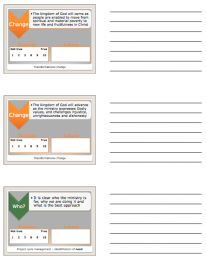 The Process
The Process
When launching a Health Check I first encourage all team members to rate the statements individually, before meeting together. I urge them not to think too deeply; respond to the first impression they may have about a particular statement and its relevance to their particular ministry.
When the team does come together they then take each group of statements, such as those in the first category ‘Spiritual Oversight’, and compare their gradings. Although it is important to discuss every statement, initially attention should particularly be given to those areas where gradings differ significantly between team members. As illustrated in a previous posting, this may highlight a fundamental flaw in relationship, team communication etc. In event of that being the case it is helpful to address this at an early stage in the process.
Next, look for the ‘low’ gradings – you may even like to take an average of the team’s figures. Ask such questions as:
- Why are they low?
- Is it correct that the statement does not apply or has it never been considered?
- If the latter, should it now be considered?
And so the discussion develops.
Results
After each discussion it is vital to draw conclusions and to agree any actions that need to be taken (e.g. in the illustration in the last posting the action would be the discussion with an elder).
How are these discussions recorded? This takes us to a consideration of the group dynamics of the process.
Group dynamics
In any discussion of this sort there needs to be a mixture of comfortable relationship (you are, after all, a team) and appropriate structure to achieve the task.
I recommend the following:
- Consider who is best to lead the discussion. Don’t assume the team leader is the best person. It is possible that he or she has more to say about certain topics than other team members in which case it can be unwise for that person to be the discussion leader – it is too easy to abuse the position and ‘hold the floor’ too much.
Is there someone else who may be better at handling the discussion? This frees up the team leader to speak without dominating. It may even be worth considering a facilitator who is not even a member of the team. This is how I helped the ministry in my own church as I am not actively involved.  There needs to be a Note Taker. Detailed minutes are probably not needed but care does need to be taken to record the results of the discussion and actions that are agreed.
There needs to be a Note Taker. Detailed minutes are probably not needed but care does need to be taken to record the results of the discussion and actions that are agreed.
I present the material through PowerPoint so I print a ‘3 per sheet’ handout for the members. This also provides a format for the Note Taker.
Don’t forget to agree a time for reviewing progress on the actions! This is also recorded on the handout.- Team members. Some will be quick to speak, others may be more reflective i.e. people are the external or internal thinkers. Often the quieter ones have valuable and carefully considered opinions, so it is important that the discussion leader ensures everyone expresses their thoughts.
- Everything is acceptable. It is essential that no-one’s thoughts are quickly dismissed. If this happens that person will be reluctant to contribute again as his ideas were not seen as acceptable.
In the final two parts of this series we will list all the statements so that you have the whole body of material available to you in condensed form.
